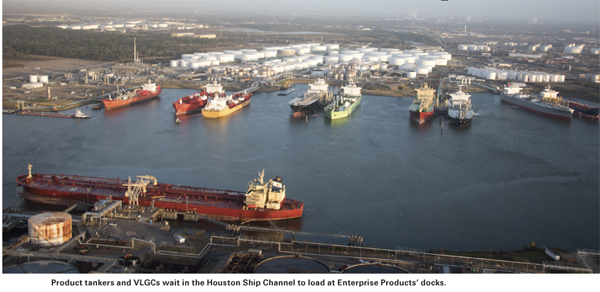Wednesday, May 3, 2017
Enterprise Products Partners LP (Houston) announced in April that combined exports and imports of hydrocarbons across its marine terminals, including 18 deep-water docks along the Texas Gulf Coast, totaled a record-setting 146 MMbbl on a gross basis during the first quarter of 2017. The previous quarterly record was 136 MMbbl in the second quarter of 2016. The loading of NGLs, crude oil, condensate, refined products, and petrochemicals accounted for about 62 percent of total marine terminal volumes in the first quarter of 2017. 
Average daily marine terminal volumes by product for the first quarter—before accounting for net interest in joint ventures were: crude oil 648,000 bbld; NGLs 569,000 bbld; refined products 384,000 bbld; and petro-chemicals 15,000 bbld.
“Our marine terminals reported a 16% increase in gross volumes for the first quarter of 2017 compared to the first quarter of 2016 to a record 146 million barrels, or 1.6 million barrels per day,” said A.J. (Jim) Teague, CEO of Enterprise’s general partner. “Gross NGLs and crude oil marine terminal volumes for the first quarter of 2017 increased by 25% and 9%, respectively, compared to the first quarter of 2016.”
Teague outlined that Enterprise’s hydrocarbons terminal on the Houston Ship Channel, the largest of its marine terminals, accounted for about 60%, or nearly 933,000 bbld, of total volumes handled in the first quarter this year. “It is well positioned to facilitate the growing global appetite for U.S.-produced NGLs, crude oil, condensate, refined products, and petrochemicals,” he said. “With our recent investments in dock expansions, this facility has the capacity to handle up to 2 million barrels per day, depending on the mix of hydrocarbon cargos and imports versus exports.”
Teague added that he believes the Houston Ship Channel has been a victim of erroneous claims of growing congestion, and that large-vessel traffic has essentially been flat since 2012. “The Houston Ship Channel has the capability to handle much more deep-draft activity as the average daily movements are less than 60% of their peak single-day record, according to the Greater Houston Port Bureau. When it comes to access to onshore storage facilities, vessel traffic service, two-way traffic, max draft, beam and air draft dimensions, number of pilots, and lack of military and off shore platform limitations, our experience tells us the Houston Ship Channel is the crown jewel of ports on the Texas Gulf Coast,” Teague asserted.

Average daily marine terminal volumes by product for the first quarter—before accounting for net interest in joint ventures were: crude oil 648,000 bbld; NGLs 569,000 bbld; refined products 384,000 bbld; and petro-chemicals 15,000 bbld.
“Our marine terminals reported a 16% increase in gross volumes for the first quarter of 2017 compared to the first quarter of 2016 to a record 146 million barrels, or 1.6 million barrels per day,” said A.J. (Jim) Teague, CEO of Enterprise’s general partner. “Gross NGLs and crude oil marine terminal volumes for the first quarter of 2017 increased by 25% and 9%, respectively, compared to the first quarter of 2016.”
Teague outlined that Enterprise’s hydrocarbons terminal on the Houston Ship Channel, the largest of its marine terminals, accounted for about 60%, or nearly 933,000 bbld, of total volumes handled in the first quarter this year. “It is well positioned to facilitate the growing global appetite for U.S.-produced NGLs, crude oil, condensate, refined products, and petrochemicals,” he said. “With our recent investments in dock expansions, this facility has the capacity to handle up to 2 million barrels per day, depending on the mix of hydrocarbon cargos and imports versus exports.”
Teague added that he believes the Houston Ship Channel has been a victim of erroneous claims of growing congestion, and that large-vessel traffic has essentially been flat since 2012. “The Houston Ship Channel has the capability to handle much more deep-draft activity as the average daily movements are less than 60% of their peak single-day record, according to the Greater Houston Port Bureau. When it comes to access to onshore storage facilities, vessel traffic service, two-way traffic, max draft, beam and air draft dimensions, number of pilots, and lack of military and off shore platform limitations, our experience tells us the Houston Ship Channel is the crown jewel of ports on the Texas Gulf Coast,” Teague asserted.

